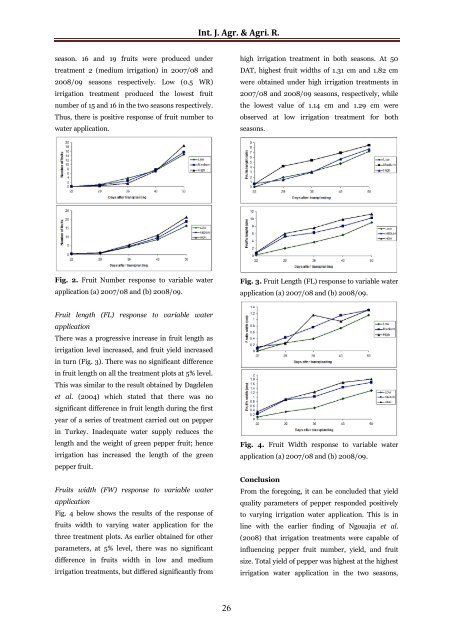Yield quality response (YQR) of pepper under variable water application using micro-sprinkler system
Abstract Yield quality response of pepper (Capsicum annum) under variable water application was examined during two off-seasons of 2007/08 and 2008/09 at the Agricultural Engineering Research Farm of the Federal University of Technology, Akure, Nigeria. The crop was irrigated using micro-sprinkler system that allowed three treatments 1, 2, 3 at 0.5 WR (water requirements) of pepper, 0.75 WR, and 1 WR respectively. The experiment was repeated twice and irrigation was carried out at 3-day interval. Soil and agronomic measurements were carried out at each treatment during the experiments while moisture content was monitored weekly using gravimetric method. Measurements made included leaf area index (LAI) and crop yield (results not shown), plant height (PH), fruit number (FN), fruit length (FL) and Fruit Width (FW). Results showed that the growth of pepper were not statistically different among treatments at the 5% level of significance. Plant height responded positively to increased water application and thus influencing yield positively. Yield of pepper was highest at the highest water application, ranging from 20.1 t/ha (2007/08) to 21.1 t/ha (2008/09); fruit number ranged between 21 to 19 for the highest treatment in 2007/08 and 2008/09 respectively while fruit length and fruit width also increased with increasing water application. It was then concluded that variations in water application might significantly influence yield quality such as fruit number, fruit length and fruit width at harvest. Variable irrigation water application for field grown pepper is therefore recommended for higher and better quality yields.
Abstract
Yield quality response of pepper (Capsicum annum) under variable water application was examined during two off-seasons of 2007/08 and 2008/09 at the Agricultural Engineering Research Farm of the Federal University of Technology, Akure, Nigeria. The crop was irrigated using micro-sprinkler system that allowed three treatments 1, 2, 3 at 0.5 WR (water requirements) of pepper, 0.75 WR, and 1 WR respectively. The experiment was repeated twice and irrigation was carried out at 3-day interval. Soil and agronomic measurements were carried out at each treatment during the experiments while moisture content was monitored weekly using gravimetric method. Measurements made included leaf area index (LAI) and crop yield (results not shown), plant height (PH), fruit number (FN), fruit length (FL) and Fruit Width (FW). Results showed that the growth of pepper were not statistically different among treatments at the 5% level of significance. Plant height responded positively to increased water application and thus influencing yield positively. Yield of pepper was highest at the highest water application, ranging from 20.1 t/ha (2007/08) to 21.1 t/ha (2008/09); fruit number ranged between 21 to 19 for the highest treatment in 2007/08 and 2008/09 respectively while fruit length and fruit width also increased with increasing water application. It was then concluded that variations in water application might significantly influence yield quality such as fruit number, fruit length and fruit width at harvest. Variable irrigation water application for field grown pepper is therefore recommended for higher and better quality yields.
You also want an ePaper? Increase the reach of your titles
YUMPU automatically turns print PDFs into web optimized ePapers that Google loves.
Int. J. Agr. & Agri. R.<br />
season. 16 and 19 fruits were produced <strong>under</strong><br />
treatment 2 (medium irrigation) in 2007/08 and<br />
2008/09 seasons respectively. Low (0.5 WR)<br />
irrigation treatment produced the lowest fruit<br />
number <strong>of</strong> 15 and 16 in the two seasons respectively.<br />
Thus, there is positive <strong>response</strong> <strong>of</strong> fruit number to<br />
<strong>water</strong> <strong>application</strong>.<br />
high irrigation treatment in both seasons. At 50<br />
DAT, highest fruit widths <strong>of</strong> 1.31 cm and 1.82 cm<br />
were obtained <strong>under</strong> high irrigation treatments in<br />
2007/08 and 2008/09 seasons, respectively, while<br />
the lowest value <strong>of</strong> 1.14 cm and 1.29 cm were<br />
observed at low irrigation treatment for both<br />
seasons.<br />
Fig. 2. Fruit Number <strong>response</strong> to <strong>variable</strong> <strong>water</strong><br />
<strong>application</strong> (a) 2007/08 and (b) 2008/09.<br />
Fig. 3. Fruit Length (FL) <strong>response</strong> to <strong>variable</strong> <strong>water</strong><br />
<strong>application</strong> (a) 2007/08 and (b) 2008/09.<br />
Fruit length (FL) <strong>response</strong> to <strong>variable</strong> <strong>water</strong><br />
<strong>application</strong><br />
There was a progressive increase in fruit length as<br />
irrigation level increased, and fruit yield increased<br />
in turn (Fig. 3). There was no significant difference<br />
in fruit length on all the treatment plots at 5% level.<br />
This was similar to the result obtained by Dagdelen<br />
et al. (2004) which stated that there was no<br />
significant difference in fruit length during the first<br />
year <strong>of</strong> a series <strong>of</strong> treatment carried out on <strong>pepper</strong><br />
in Turkey. Inadequate <strong>water</strong> supply reduces the<br />
length and the weight <strong>of</strong> green <strong>pepper</strong> fruit; hence<br />
irrigation has increased the length <strong>of</strong> the green<br />
<strong>pepper</strong> fruit.<br />
Fruits width (FW) <strong>response</strong> to <strong>variable</strong> <strong>water</strong><br />
<strong>application</strong><br />
Fig. 4 below shows the results <strong>of</strong> the <strong>response</strong> <strong>of</strong><br />
fruits width to varying <strong>water</strong> <strong>application</strong> for the<br />
three treatment plots. As earlier obtained for other<br />
parameters, at 5% level, there was no significant<br />
difference in fruits width in low and medium<br />
irrigation treatments, but differed significantly from<br />
Fig. 4. Fruit Width <strong>response</strong> to <strong>variable</strong> <strong>water</strong><br />
<strong>application</strong> (a) 2007/08 and (b) 2008/09.<br />
Conclusion<br />
From the foregoing, it can be concluded that yield<br />
<strong>quality</strong> parameters <strong>of</strong> <strong>pepper</strong> responded positively<br />
to varying irrigation <strong>water</strong> <strong>application</strong>. This is in<br />
line with the earlier finding <strong>of</strong> Ngouajia et al.<br />
(2008) that irrigation treatments were capable <strong>of</strong><br />
influencing <strong>pepper</strong> fruit number, yield, and fruit<br />
size. Total yield <strong>of</strong> <strong>pepper</strong> was highest at the highest<br />
irrigation <strong>water</strong> <strong>application</strong> in the two seasons,<br />
26





![Review on: impact of seed rates and method of sowing on yield and yield related traits of Teff [Eragrostis teff (Zucc.) Trotter] | IJAAR @yumpu](https://documents.yumpu.com/000/066/025/853/c0a2f1eefa2ed71422e741fbc2b37a5fd6200cb1/6b7767675149533469736965546e4c6a4e57325054773d3d/4f6e6531383245617a537a49397878747846574858513d3d.jpg?AWSAccessKeyId=AKIAICNEWSPSEKTJ5M3Q&Expires=1714914000&Signature=GeIxE5IpRWvl1qY2uq7mHnJWVA4%3D)












